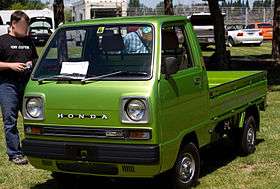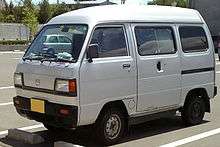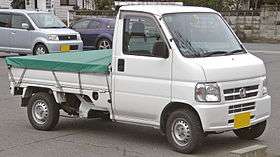Honda Acty
| Honda Acty | |
|---|---|
 | |
| Overview | |
| Manufacturer | Honda |
| Production | 1977–present |
| Assembly |
Suzuka Plant, Suzuka, Mie, Japan Yachiyo Plant, Yokkaichi, Mie, Japan (starting 1985) |
| Body and chassis | |
| Class |
Microvan kei truck |
| Body style |
5-door Van 2-door Pickup truck |
| Layout | Mid-engine, rear-wheel drive / four-wheel drive. |
| Related | Honda Vamos |
| Chronology | |
| Predecessor |
|
The Honda Acty is a series of microvans and kei trucks by Japanese automaker Honda, designed for the Japanese domestic market. "Acty" is short for "Activity".
The Acty competes with the Subaru Sambar, Suzuki Carry, Daihatsu Hijet, and the Mitsubishi Minicab.
History
The Acty range is designed to be economical, agile work vehicles, and generally lack luxury options, although air conditioning and power steering are available along with various trim, decoration, and customization options. The first generation was produced from 1977 to 1988 (model series TA, TB, TC, VD, VH), the second generation's years were 1988-1999 (model series HA1, HA2, HH1, HH2 with the E05A engine; HA3, HA4, HA5, HH3, HH4 with the EN07A engine - the Street continued in production until 2011) and the third generation's years were 1999-2009 (model series HA6, HA7, HH5, HH6 with E07Z engine) with the van still in production. The fourth generation was introduced, as a truck only, at the 41st Tokyo Motor Show in 2009 on December 17, showing the HA8 series and continuing to use the E07Z engine. Since the merger of the Subaru Sambar and Daihatsu Hijet, the Acty truck has become the only remaining Kei truck not to have a front-engine, rear-wheel-drive layout.
First generation
| First generation | |
|---|---|
 Pre-facelift Acty truck | |
| Overview | |
| Manufacturer | Honda |
| Also called | Honda Street |
| Production | July 1977–1988 |
| Body and chassis | |
| Body style |
|
| Layout | Mid-engine, rear-wheel drive / four-wheel drive. |
| Powertrain | |
| Engine | 545 cc EH SOHC 2-cylinder |
| Transmission | |
| Dimensions | |
| Wheelbase | 1,850 mm (73 in) |
| Length | 3,195 mm (125.8 in) |
| Width | 1,395 mm (54.9 in) |
| Height |
|
| Curb weight | 590 kg (1,300 lb) (truck) |
The first Acty trucks were introduced July 27, 1977, and replaced several Kei trucks Honda had previously offered, such as the Honda TN360 (most recently sold as the TN7) and the Honda T360. On 1 September 1975, the Japanese Government revised the rules on Road Trucking Vehicle Law that regulated the dimensions and engine size of vehicles in this class. As a result, the first Acty trucks and vans were available with a "midship" mounted 545 cc 2-cylinder SOHC water-cooled engine, known as the EH engine, which produces 28 PS (20.6 kW) at 5500 rpm and 4.2 kg·m (41 N·m; 30 lb·ft) at 4000 rpm. This was about 50% larger than the engine used in the preceding TN7. Export models, with less emissions equipment, claim 30.6 hp (22.8 kW; 31.0 PS) at the same engine speed.[1]


The van was introduced November 1979, although a truck-based panel van with a boxy rear was available from the beginning (TB).[2] To save money, the van uses the same taillights as the truck and also has side doors with center mounted handles, meaning that the same pressing can be used for either side of the car. The Acty was exported to a number of markets, including Great Britain, where it is considered to have created an entire new category. The Suzuki Carry/Bedford Rascal was GM's response to the Acty in the British market.[3]
An upper trim level of the Acty van intended mainly for passenger usage went on sale 1 February 1981 and was called the Honda Street (Japanese); it was produced for two generations of the Acty van. Available with a standard or an all-new high roof design, the high roof was also made available for the Acty van (SDX only).[4] The name was discontinued in 2001 after the Honda Vamos name had been reintroduced as a replacement trim level for the Street, on a shared platform of the Acty van. In March 1983 the four-wheel drive Acty/Street was added. This model receives 12-inch wheels for increased ground clearance and has an engine with an improved cylinder head, increasing power to 29 PS (21.3 kW) at 5300 rpm and torque to 4.5 kg·m (44 N·m; 33 lb·ft) at 3500 rpm.[5] This was also the first Acty/Street to receive a five-speed manual gearbox, initially only available on the 4WD models. A larger, 35 L (9.2 US gal) was also part of the 4WD's equipment.[5]
In June 1982 the series received a facelift, with wraparound turn signals. While the Acty has round headlamps, the Street received square units after the facelift. Starting with model year 1985, the Acty/Street was exclusive to a chain of Japanese Honda dealerships established for small and commercial vehicles, called Honda Primo.
Export versions
The Acty was also sold in a few export markets, such as the United Kingdom and Australia. Subsequent models were marketed almost entirely in the Japanese domestic market only. As a bit of an oddity, the Acty was sold during 1982 in Australia, but was made unavailable inside of Sydney due to concerns by Honda that the vehicle was under-powered for the hilly terrain.
Second generation
| Second generation | |
|---|---|
|
Acty truck (early) | |
| Overview | |
| Manufacturer | Honda |
| Also called | Honda Street |
| Production | March 1988–May 1999 |
| Body and chassis | |
| Body style |
|
| Layout | Mid-engine, rear-wheel drive / four-wheel drive. |
| Powertrain | |
| Engine | |
| Transmission | |
| Dimensions | |
| Wheelbase | 1,900 mm (75 in) |
| Length | 3,195–3,295 mm (125.8–129.7 in) |
| Width | 1,395 mm (54.9 in) |
| Height |
|
| Curb weight | 670–870 kg (1,480–1,920 lb) |
The second generation Acty was launched in March 1988 with the introduction of the Honda E05 engine, with an additional cylinder added, making it a 547 cc 3-cylinder with SOHC. The engine is rated 34 PS (25 kW) at 5500 rpm and 4.5 kg·m (44 N·m; 33 lb·ft) at 5000 rpm.[6] The first models were the Acty truck and van, with the commercial grade Acty van appearing a month later. The 4WD models were no longer available with an automatic transmission. There was also an "Acty Attack" version of the truck, intended for farmers in particular this model has a differential lock in the rear and features Ultra-Low forward and reverse gears (UL/UR).[6]

The original Actys have distinct round headlights while the Street has large, rectangular headlamps.[6] The truck and van originally shared the same taillights. After the March 1990 facelift the Acty received the same headlights as the Street, while all models grew longer by 10 cm (3.9 in) as the result of altered kei car regulations. At this time the Street also received the taillights from the contemporary Honda Today (which were also used for the third generation Acty van). The 1990 changeover also meant that the 547 cc engine was replaced with the larger 656 cc Honda E07A engine (with fuel injection added in 1996). The carburetted version of this engine produced 38 PS (28 kW) at 5300 rpm and 5.5 kg·m (54 N·m; 40 lb·ft) at 4500 rpm. The Street could reach a top speed of 115 km/h (71 mph), while the four-wheel drive version only could attain 105 km/h (65 mph).[7]
In October 1993 the Honda Street's front design was changed yet again, receiving larger, more square headlamp units. A PGM-FI version in "Fox" and "Xi" equipment levels was also introduced to the Street at this time. This version produces 44 PS (32 kW). The front end changes were applied to the Acty as well, beginning in January 1994. The Acty and the Street were further modified in January 1996 when the turn signals were changed from amber to clear. At this time, the fuel injected Acty SDX-Hi was also introduced - only with two-wheel drive and a five-speed manual - with the same engine as the Street Xi (the Fox was dropped, replaced by the carburetted Street V). Production of the Acty continued until the arrival of the third generation in 1999, although the Honda Street continued to be built until 2001 as it was only partially replaced by the pricier Honda Vamos.
Third generation
| Third generation | |
|---|---|
 | |
| Overview | |
| Manufacturer | Honda |
| Production |
|
| Body and chassis | |
| Body style |
|
| Layout | Mid-engine, rear-wheel drive / four-wheel drive. |
| Related | Honda Vamos |
| Powertrain | |
| Engine | 656 cc E07Z SOHC I3 |
| Transmission | |
| Dimensions | |
| Wheelbase | 2,420 mm (95 in) |
| Length | 3,395 mm (133.7 in) |
| Width | 1,475 mm (58.1 in) |
| Height |
|
| Curb weight | 800–1,030 kg (1,760–2,270 lb) |
The third generation Acty truck was introduced on 27 May 1999. The van went on sale one month later.[8] On September 30, 1996, the Japanese Government amended the Enforcement Regulations Vehicle Law, Ministerial Ordinance No. 53, which addressed safety requirements for front passengers, but did not allow for larger overall dimensions. Honda pushed the driving position back while keeping the engine in its traditional location underneath the vehicle. The new design retained the mid-engined, rear-wheel-drive layout although it was now of a "semi-bonneted" design. Meeting the increased safety requirements was a major focus during development.[8] The base price of the pickup model is ¥777,000 (approximately $7,920 USD), with the van starting at ¥1,060,500 (approximately $10,810 USD) as of December 2008. Four-wheel drive is available as an option on all vans, and all but one model of pickup truck, making the Acty one of a handful of mid-engine, AWD vehicles that are not designed as supercars.
.jpg)
The 656 cc engine is of an LEV design, with low emissions and high gas milage. fuel economy was further increased by the use of electric power steering. Max power in 1999 was 46 PS (34 kW) at 5000 rpm. The engine was since upgraded to the current 660 cc 12-valve inline-three E07Z gasoline engine making 53 PS (39 kW) at 7000 rpm and 6.2 kg·m (61 N·m; 45 lb·ft) at 4000 rpm (4WD models). Currently, the maximum payload is 200 kg (440 lb). The truck was available as a basic standard model, SDX (Super Deluxe) and more comfortable Town versions. There was also the Acty Attack, a spartanly equipped four-wheel drive version with a differential lock, particularly intended for farmers. The van was available as a two-seater Pro-B (with division) or as the somewhat more comfortable Pro-A. There were also four-seater SDX and Town versions.[8] The "Street" name was discontinued in favor of the Honda Vamos, based on the Acty van. In December 2009 the Acty truck was replaced by the new fourth generation model, but the bonneted Acty van continued to be produced with the third generation bodywork.
Fourth generation (truck)
On 17 December 2009 the fourth generation Acty truck was introduced. As for the Daihatsu Hijet and Suzuki Carry competitors, this model has become delinked from the van as a result of differing safety requirements for commercial vehicles and passenger-type vans. It continues to use the predecessor and van's E07Z engine, although now with 45 PS (33 kW). The chassis codes are HA8 (2WD) or HA9 (4WD). The wheelbase was shortened dramatically, returning to the 1.9 m (6.2 ft) as used on the second generation Acty, in order to increase cabin space and to shrink the turning circle. In June 2012 the Acty underwent some light modifications so as to meet new upcoming standards on lighting.
References
- ↑ Wren, Tim (June 1986). "Light Match". TRUCK. London, UK: FF Publishing Ltd: 78.
- ↑ 自動車ガイドブック [Japanese Motor Vehicles Guide Book] (in Japanese). Japan: Japan Automobile Manufacturers Association. 25: 209. 1978-10-10. 0053-780025-3400. Missing or empty
|title=(help) - ↑ Wren, p. 76
- ↑ ホンダ軽商用車アクティシリーズを充実好評のアクティ・シリーズにハイルーフ仕様を追加新発売。 [Honda adds a high-roof model to its popular Acty series of kei commercial vehicles] (Press Information) (in Japanese). Honda Motor Co. 1981-01-27. Retrieved 2014-09-26.
- 1 2 扱いやすく、燃料経済性に優れた5速タイプの「ホンダ アクティ4WD」を発売 [Easy to handle and with excellent fuel economy, the five-speed Honda Acty 4WD is released] (Press Information) (in Japanese). Honda Motor Co. 1983-03-09. Retrieved 2014-09-26.
- 1 2 3 四輪製品ニュース [Four-wheeled product news] (Press Information) (in Japanese). Honda Motor Co. 1988-05-10. Retrieved 2014-09-25.
- ↑ Quattroruote: Tutte le Auto del Mondo 1992 (in Italian). Milano: Editoriale Domus S.p.A. 1992. p. 382.
- 1 2 3 新規格の軽商用車: 新型「アクティ・トラック/バン」を発売 [Kei cars to the new regulations: New Honda Acty truck and van] (Press Information) (in Japanese). Honda Motor Co. 1999-05-27. Retrieved 2014-09-25.
External links
| Wikimedia Commons has media related to Honda Acty. |
- Honda Acty Truck webpage
- Honda Acty Van webpage
- ThisOldHonda.org Acty
- Honda Acty Talk and Information
| Honda road car timeline, 1960s–1980s — next » | ||||||||||||||||||||||||||||||||
|---|---|---|---|---|---|---|---|---|---|---|---|---|---|---|---|---|---|---|---|---|---|---|---|---|---|---|---|---|---|---|---|---|
| 1960s | 1970s | 1980s | ||||||||||||||||||||||||||||||
| 0 | 1 | 2 | 3 | 4 | 5 | 6 | 7 | 8 | 9 | 0 | 1 | 2 | 3 | 4 | 5 | 6 | 7 | 8 | 9 | 0 | 1 | 2 | 3 | 4 | 5 | 6 | 7 | 8 | 9 | |||
| Kei car | N360 N600 |
Z360/Life | Today | |||||||||||||||||||||||||||||
| Subcompact | Z600 | Civic | City/Jazz | City | ||||||||||||||||||||||||||||
| Compact | Civic | Civic | Civic | |||||||||||||||||||||||||||||
| 1300/145 | Ballade | Ballade | Concerto | |||||||||||||||||||||||||||||
| Quint/Quintet | Quint Integra | |||||||||||||||||||||||||||||||
| Mid-size | Accord | Accord | Accord | |||||||||||||||||||||||||||||
| Full-size | Legend | |||||||||||||||||||||||||||||||
| Coupé | CRX | CRX | ||||||||||||||||||||||||||||||
| Prelude | Prelude | Prelude | ||||||||||||||||||||||||||||||
| Sports | S500 | S600 | S800 | |||||||||||||||||||||||||||||
| Compact MPV | L700/800 | Vamos | ||||||||||||||||||||||||||||||
| Kei truck/van | T360/500 | TN360 | TNIII | TN-V | TN7 | Acty/Street | ||||||||||||||||||||||||||